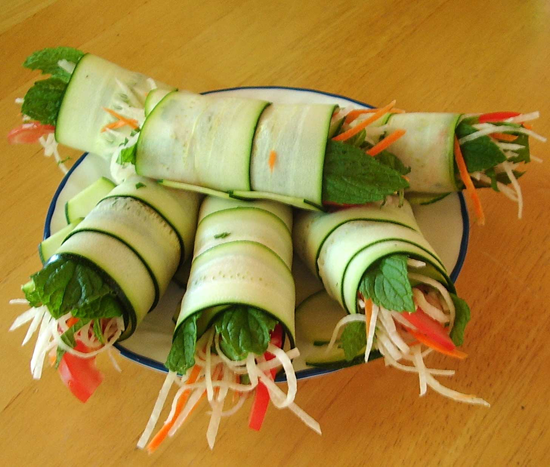
Image from http://adkjerseygirl.wordpress.com/2012/05/01/what-is-going-raw/
By Joan Kent
I”™m often asked for my opinion about raw food diets, so I've done some research on them. Here”™s what I think.
On the surface, it seems reasonable that raw foods would be better for us. After all, every process we put our food through, from start to finish, detracts at least a little from the nutrition. Raw foods would undergo the least processing, so they”™d be more nutritious. Perhaps because of that, many raw foodies say they feel more energetic on a raw diet.
A couple of problems may occur with raw diets, though. One has to do with substances called goitrogens that some foods contain. These goitrogens can interfere with thyroid function, making it wise to limit or even avoid foods that contain them.
So which foods contain goitrogens? The list includes cabbage, peanuts, pine nuts, broccoli, Brussels sprouts, kale, spinach, bok choy, cauliflower, soy, mustard greens, collards, radishes, turnips, and more. As you know, some of these foods have a well-deserved reputation for being nutrition-packed all-stars, so we don”™t necessarily want to eliminate them.
The good news is that heat from cooking can effectively destroy goitrogens, so these very healthful foods can still be part of your diet — as long as you let go of the raw rule where they”™re concerned. I was in the habit of juicing several of these raw foods and stopped when I learned this information. Now I always steam or saute them. In the case of soy, fermentation (miso, tempeh) will do the trick.
Another problem I”™ve seen has to do with which “track” the individual chooses. It actually appears to be quite clear-cut: Some raw foodies go in the vegetable direction, some in the fruit direction. It”™s the fruit direction that concerns me. Fructose, the sugar in fruit, is nasty stuff.
Health-wise, fructose can induce insulin resistance, decrease glucose tolerance (both may lead to diabetes); increase blood pressure; increase LDL (bad) cholesterol or make it smaller, denser and more likely to form arterial plaque; raise triglycerides and risk for heart disease; rapidly convert to body fat; increase clotting; interfere with copper absorption, which is necessary for hemoglobin; and cause cavities. It doesn”™t stimulate leptin and or suppress ghrelin, leading to increased appetite. It”™s addictive, may stimulate sugar cravings, and can cause malabsorption and gastro-intestinal disturbances.
Fructose is also a relatively ineffective training fuel, either pre- or post-training. It absorbs less rapidly than glucose during exercise, promotes less water uptake, leading to dehydration, blocks sodium absorption, and replaces glycogen poorly.
Raw foodies who favor fruit tell me how great it is to “eat raw” because they “can have pie for breakfast”, and it”™s perfectly fine because it”™s raw. The pie shell is typically made from crumbled nuts, while the pie filling is fruit puree. Variations on this theme can be found in stores. Whole Foods, for example, sells cookies resembling Oreos, with a cookie made of crumbled nuts and filled with a paste-like fruit puree.
The advantages of raw food diets would seem to lie in the consumption of lots of vegetables, as well as the elimination of many unwholesome foods. Someone who goes from eating lots of bread, cakes, desserts, and other sugar- or gluten-containing foods to eating plenty of raw vegetables will undoubtedly experience a noticeable shift in health, weight, energy, and symptom management.
But if you”™ve already made healthful changes in your diet and don”™t eat much junk of any kind, you”™ll probably notice a less dramatic change when switching to raw foods. Even a subtle change may feel worth it to you, however, so make your own decision.
If you decide to switch to a raw diet, please do yourself a big health favor and lean toward adding more vegetables to your meals, rather than fruit. My suggestions here are simple: Cook any foods that contain goitrogens, and get on the raw vegetable track, rather than the fruit track.
Fructose is sugar, no mistake. And in quantity, fruit and fructose can pack quite a mean punch. The fact that they”™re raw won”™t change that.
- New Year’s Resolutions: A Sugar Addict’s Survival Guide - April 15, 2024
- Motivation vs. Enthusiasm - October 12, 2023
- Why Exercise Shouldn’t Be Just One Thing - November 9, 2022

Well written and informative as usual Joan. Your comment, “…don’t eat much junk of any kind…” does seem to go to the heart of of the matter. Garbage in Garbage out kind of thing.
So it sounds like you wouldn’t recommend going raw cold turkey. First improve ones nutrition by eliminating garbage then switch to raw. One more question, protein, where does one get it from a raw diet?
Thanks Joan.
Chuck,
I actually wasn’t suggesting going in stages when switching to raw foods. I merely meant to contrast the degree of change someone could reasonably expect when switching. Going from a junk-food diet to raw would very like cause dramatic shifts, whereas the changes might be more subtle for someone who was already following good dietary guidelines.
Protein can be tricky on a raw foods diet. Nuts are considered protein by many people, but I disagree. They’re primarily monounsaturated fat, and have about the same amount of carb as protein. Although I typically recommend eating “real” foods, I do think protein is so important that supplementing with protein powder is acceptable. One good brand is Garden of Life Raw Protein, available at Whole Foods and other stores. Obviously, it’s a good idea to stay away from protein powders with sweeteners in them, so natural is the flavor to get, rather than chocolate, vanilla or what-have-you.
Thanks,
Joan